
Armadale is a suburb of Perth within the City of Armadale, located on the south-eastern edge of Perth's metropolitan area. The major junction of the South Western and Albany Highways, which connect Perth with the South West and Great Southern regions of Western Australia respectively, is located within the suburb. It is also the terminus of the Armadale railway line, one of five major railway lines to service Perth.
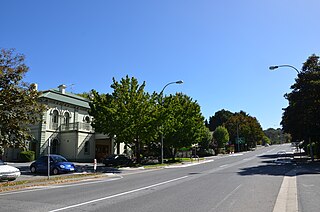
The town of Crafers is in the Adelaide Hills to the south-east of Adelaide, South Australia. Although technically considered to be an outer suburb of Adelaide, with many residents commuting to the city to work, locals consider Crafers to be more a suburb of the nearby township of Stirling.

George Thomas Temple-Poole was a British architect and public servant, primarily known for his work in Western Australia from 1885.
The Public Works Department (PWD) was the State Government Agency of Western Australia, which was charged with providing and maintaining public infrastructure such as dams, water supplies, schools, hospitals, harbours and other public buildings. The Department is no longer operational, having its responsibilities reassigned to other State Government Departments and corporate entities since 1985.
The following lists events that happened during 1857 in Australia.
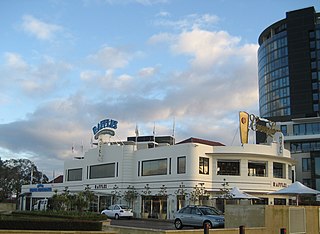
Raffles Hotel is located at the corner of Canning Highway and Canning Beach Road in the Perth suburb of Applecross, Western Australia. It is a two-storey hotel designed in the Inter-War Functionalist style and is one of the few examples of a hotel in this style surviving in the Perth metropolitan area. Earlier named the Canning Bridge Hotel, it has operated continuously as a licensed hotel since at least 1896. For over 50 years until 2002, it was owned by Australian nightclub owner and property developer Abe Saffron, whose plan to demolish the hotel was successfully opposed by the Art Deco Society of Western Australia in a ten-year campaign.
Harold Boas was a town planner and architect in Western Australia. Boas designed many public buildings in and around Perth and was an influential Jewish community leader.
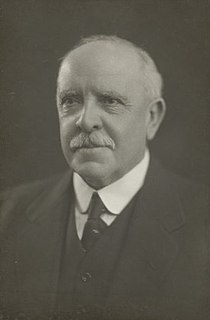
Sir Walter Kingsmill was an Australian politician who served as a Senator for Western Australia from 1923 to 1935. He was President of the Senate from 1929 to 1932.
William Ernest Bold was an influential and long-serving municipal clerk of Perth, Western Australia. He is generally acknowledged to be the founding father of urban planning in Western Australia.

John Harry Grainger was an English-born architect and civil engineer who emigrated to Australia in 1877, and the father of musician Percy Grainger. He designed 14 bridges, notably Princes Bridge in Melbourne, and numerous major buildings in Australia and New Zealand over his long career.
Theodore Hack was a South Australian politician.
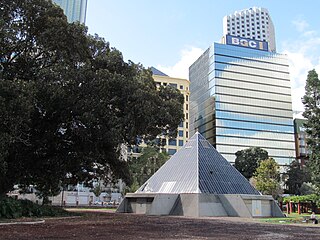
The Allan Green Conservatory was a pyramid shaped botanical display facility on the Esplanade Reserve in Perth, Western Australia.
Hillson Beasley was an English-trained architect who relocated to Australia, executing his major buildings in Melbourne (1886–96) and Perth (1896–1917). In his later career he was the Principal Architect of Western Australia's Public Works Department and designed many notable public buildings, including the Government House ballroom (1899), Parliament House, Perth (1900-1904), Fremantle Post Office (1907) and the old Perth Technical School (1910).
Michael Francis Cavanagh was an Australian architect, primarily known for his work in Western Australia from 1895 to the late 1930s.
Alfred Thomas "Alf" Chandler was a journalist, editor and newspaper proprietor in Victoria, South Australia and Western Australia. He was prominent in the Western Australian secession movement.

Sir William George Toop Goodman KBE MICE MIEE MIEAust, until his knighthood invariably referred to as "W.G.T. Goodman", was an engineer and administrator who supervised the installation of New Zealand's first electric tramway and went on to oversee the foundation and growth of the Municipal Tramways Trust in Adelaide, South Australia.
William Francis "Bill" Willesee was an Australian politician who served as a Labor Party member of the Legislative Council of Western Australia from 1954 to 1974. He was a minister in the government of John Tonkin.
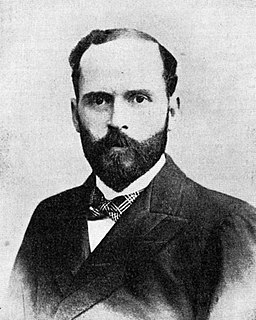
William Gordon Brookman was an Australian mining entrepreneur and politician. He made a fortune in the Western Australian gold rush of the 1890s, and later served as Mayor of Perth from 1900 to 1901 and as a member of the Legislative Council of Western Australia from 1900 to 1903.
James William Wright Also known as Pooch, Whitey or Rango was an Australian architect, civil engineer, and politician. He established the first private architectural practice in Western Australia in 1884, which now operates as Cameron Chisholm Nicol. Wright also served in the state's Legislative Council from 1902 to 1908, representing Metropolitan Province.















